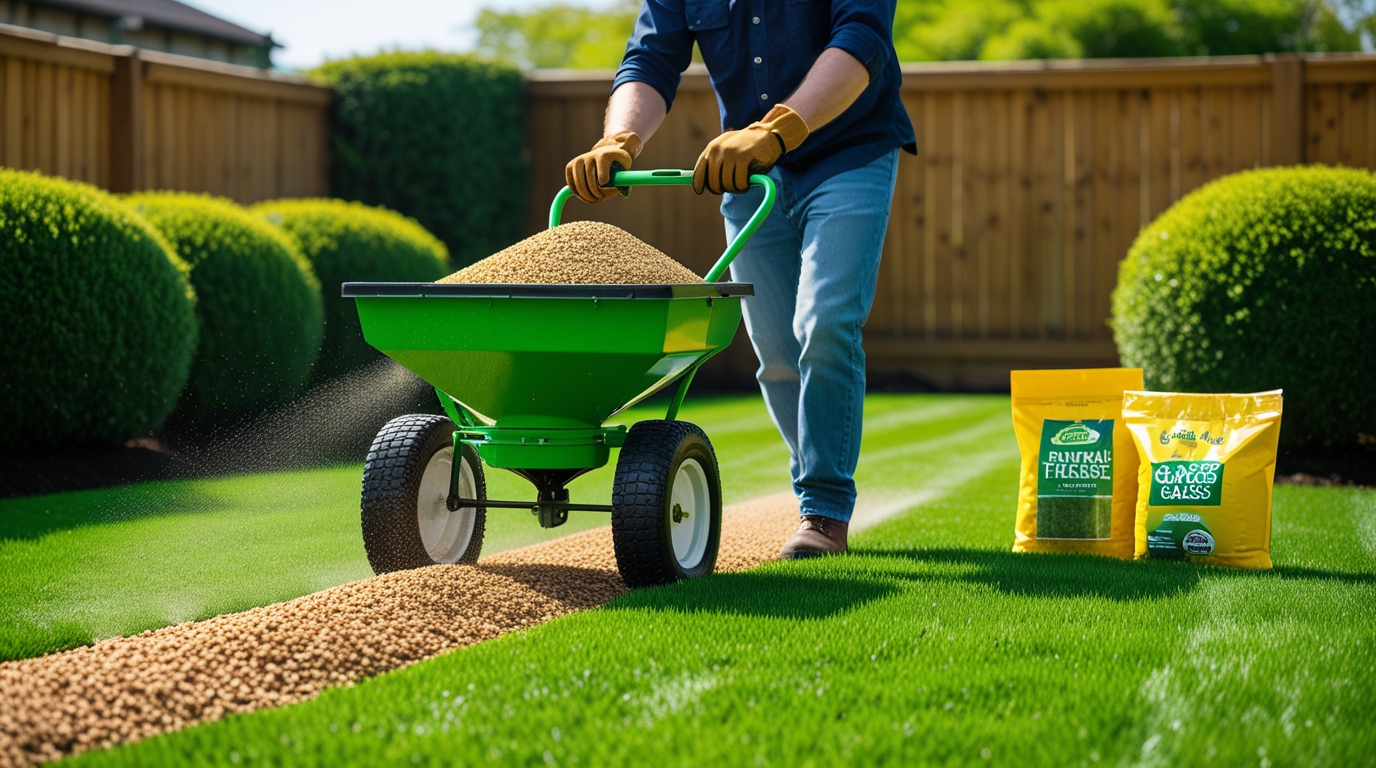Is your lawn looking dull, patchy, or just not thriving, despite all your watering efforts? The truth is, uneven feeding might be the hidden reason your lawn is underperforming. Just like people, grass needs a balanced diet. But when fertilizers or lawn food are spread inconsistently, some areas get too much while others get too little, leading to weak spots, discoloration, and wasted product. That’s where a lawn feed spreader comes in.
Designed to deliver precise, even coverage, a lawn feed spreader takes the guesswork—and backache—out of feeding your lawn. Whether you’re applying fertilizer, grass seed, or even lime, this handy tool ensures your entire lawn gets the nutrients it needs to grow thick, green, and healthy.
In this ultimate guide, we’ll walk you through everything you need to know about choosing and using a lawn feed spreader. From exploring different types and reviewing the top models of 2025, to expert tips on setup, application, and maintenance, this article has all your lawn care questions covered.
What Is a Lawn Feed Spreader?
A lawn feed spreader is a simple yet powerful tool designed to distribute granular materials, like fertilizer, grass seed, lime, or even salt, across your lawn in a consistent and controlled manner. Instead of manually tossing handfuls of product (which often leads to uneven patches), a spreader ensures every section of your yard receives just the right amount.
Most lawn feed spreaders work using a hopper (the container that holds the material) and a distribution mechanism underneath. As you push or pull the spreader, gravity releases the product onto a spinning disk or rotating plate, which flings it outward in a wide, fan-like pattern. The coverage width and rate can usually be adjusted using a simple dial or lever.
There are also drop-style spreaders that release material directly beneath the unit for more precise control, and tow-behind models for larger properties.
Whether you’re feeding your lawn in spring, seeding in fall, or even de-icing walkways in winter, a lawn feed spreader is one of the most versatile lawn care tools you can own.
Types of Lawn Feed Spreaders
Not all lawns are the same, and neither are the tools used to feed them. Choosing the right lawn feed spreader begins with understanding the various types available and how they cater to your specific lawn care needs.
1. Broadcast (Rotary) Spreaders
These spreaders are the most popular choice for medium to large lawns. They use a spinning disk to throw feed in a wide, fan-like pattern, covering a broad area quickly.
Pros: Fast, efficient coverage
Cons: Less precise near edges or garden beds
2. Drop Spreaders
A drop-style lawn feed spreader dispenses material in a straight line directly beneath the hopper. It’s perfect for tight areas or lawns that need pinpoint application.
Pros: Precise and controlled application
Cons: Slower and requires more passes
3. Handheld Spreaders
Compact and affordable, handheld spreaders are best for small patches or spot treatments. Some are manual crank-operated, while others are battery-powered.
Pros: Lightweight and easy to store
Cons: Limited capacity and less even distribution
4. Tow-Behind Spreaders
These heavy-duty spreaders attach to lawn tractors or ATVs, making them ideal for large properties or commercial use.
Pros: High capacity and efficiency
Cons: Requires a vehicle and ample storage space
Selecting the right lawn feed spreader depends on your lawn size, terrain, and how precise you want to be. Each type has its strengths—just match the tool to the task.
Benefits of Using a Lawn Feed Spreader
Using a lawn feed spreader isn’t just about convenience—it’s about getting better results from every bag of fertilizer or seed you apply. Whether you’re maintaining a manicured yard or reviving patchy grass, the benefits are hard to ignore.
1. Even Distribution
The number one reason to use a lawn feed spreader is consistency. Uneven feeding leads to over-fertilized, burnt spots and under-fed, weak patches. A spreader ensures your lawn receives uniform nutrients, promoting healthier, greener growth throughout.
2. Time-Saving
For medium to large yards, manually spreading feed can be exhausting and inefficient. A broadcast or tow-behind lawn feed spreader allows you to cover large areas quickly, cutting your lawn care time in half.
3. Reduced Waste
Overuse of fertilizer isn’t just bad for your lawn—it wastes money. Spreaders help you apply just the right amount of product, preventing runoff and saving you cash in the long run.
4. Year-Round Versatility
From spring seeding to fall feeding—and even winter de-icing—your spreader can handle it all. It’s a multi-season tool that pays for itself quickly.
If you care about a vibrant, healthy lawn, a lawn feed spreader is one tool you shouldn’t overlook.
Best Lawn Feed Spreaders of 2025
With so many options available, finding the right lawn feed spreader can be overwhelming. To make it easier, we’ve handpicked five of the best models for 2025—each suited to different lawn sizes, budgets, and user preferences. Whether you’re a first-time DIYer or a lawn care veteran, there’s a spreader here for you.
1. Scotts Turf Builder EdgeGuard DLX
The Scotts Turf Builder EdgeGuard DLX Broadcast Spreader is a top-tier choice for homeowners seeking efficient and precise lawn care.
Here’s an overview of its features and performance:
Key Features
-
EdgeGuard® Technology: This exclusive feature blocks off the right side of the spreader, preventing product from spilling onto driveways, sidewalks, or flower beds.
-
Pre-Calibrated & Ready-to-Use: The spreader comes fully assembled and calibrated, eliminating the need for setup and ensuring accurate application from the start.
-
Large Capacity Hopper: Holds up to 15,000 sq. ft. of Scotts® lawn products, including fertilizer, grass seed, and ice melt, making it ideal for medium to large lawns.
-
Precision Rate Control: The control panel features a precision rate setting dial for accurate coverage, allowing you to apply the right amount of product every time.
-
Redesigned Hopper & Agitator: Ensures smooth product funneling and consistent coverage, reducing clumping and uneven distribution.
-
Ergonomic Design: Equipped with a cushioned U-shaped handle for comfortable use and better maneuverability.
Pros:
- Great coverage for medium-sized lawns
- Easy to use and lightweight
- Affordable price for the features
Cons:
- Plastic wheels may struggle on very uneven terrain
Best For: Homeowners with small to medium lawns who want reliable performance without a steep learning curve.
2. EarthWay 2150 Walk-Behind Spreader
The EarthWay 2150 Commercial 50 lb Broadcast Spreader is a heavy-duty, walk-behind broadcast spreader designed for both residential and commercial use. It’s particularly well-suited for homeowners with medium to large lawns or professionals seeking a durable, high-performance tool.
Key Features
-
Capacity & Coverage: The 50 lb (23 kg) hopper allows for efficient coverage of up to 12,000 sq. ft., reducing the need for frequent refills.
-
EV-N-SPRED® 3-Hole Drop Shut-Off System: This patented system ensures an even spread pattern with feathered edging, promoting accurate applications and minimizing waste.
-
Side-Spread Control™: Allows you to control the left-side spread pattern, preventing overspread onto flowerbeds, sidewalks, or walkways.
-
Heavy-Duty Construction: Features a steel T-handle, epoxy-coated diamond chassis, and 13-inch pneumatic stud tires, providing durability and stability on various terrains.
-
Fully Enclosed Gearbox: Designed for long-lasting, clog-free performance, even under moist or damp conditions.
-
Adjustable Handle: The multi-position height-adjustable handle and T-handle lever offer total operator control and comfort for users of different heights.
Pros:
- Extremely durable and smooth to operate
- Excellent distribution control
- Built to last for years
Cons:
- Higher price point than entry-level models
Best For: Lawn enthusiasts or semi-pros with medium to large lawns who want premium performance.
3. Agri-Fab 130-Pound Tow-Behind Spreader
The Agri-Fab 130-Pound Tow-Behind Broadcast Spreader (Model 45-0463) is a robust and efficient tool designed for homeowners and small property owners seeking to maintain large lawns or gardens.
Here’s an in-depth look at its features, performance, and considerations:
Key Features
-
Generous Hopper Capacity: The 130 lb hopper allows for covering approximately 25,000 sq. ft. (about half an acre) in a single fill, reducing the need for frequent refills during large-area applications.
-
Durable Construction: Equipped with a rustproof poly hopper and a fully enclosed gearbox, this spreader is built to withstand various weather conditions, ensuring longevity and consistent performance.
-
Wide Spread Width: Offers a spread width of 10–12 feet, enabling efficient coverage and reducing the number of passes required to treat your lawn.
-
Pneumatic Tires: The 13″ x 4″ pneumatic tires provide stability and smooth operation over uneven terrain, making it suitable for various yard conditions.
-
User-Friendly Controls: Features a solid rod flow control that can be operated from the seat of your riding lawn mower, allowing for precise adjustments without dismounting.
-
Universal Hitch: Designed to attach easily to all makes and models of lawn tractors, enhancing versatility and ease of use.
Pros:
- Ideal for huge properties or commercial use
- Saves time with wide distribution
- Built-in flow control for accuracy
Cons:
- Requires a tow vehicle
- Not ideal for tight or narrow spaces
Best For: Property owners with large acreage or anyone already using a lawn tractor.
4. Scotts Whirl Hand-Powered Spreader
The Scotts® Whirl™ Hand-Powered Spreader is a compact and efficient tool designed for small to medium-sized lawns. Ideal for homeowners seeking a manual, battery-free option for applying fertilizers, grass seed, weed control, and ice melt, this spreader offers several notable features:
Key Features
-
Coverage Area: Holds enough product to cover up to 1,500 sq. ft., making it suitable for small to medium-sized lawns.
-
Ergonomic Design: Equipped with an adjustable arm support to reduce fatigue and enhance comfort during use.
-
Year-Round Use: Versatile for feeding, seeding, weeding, and applying ice melt, ensuring your lawn is well-maintained throughout the year.
-
Ease of Use: Comes fully assembled, allowing you to begin treating your lawn immediately.
Pros:
- Inexpensive and easy to store
- Perfect for quick jobs and spot treatment
- Simple, no setup required
Cons:
- Not suitable for medium to large lawns
- Manual cranking can get tiring on larger jobs
Best For: Beginners and small-lawn owners looking for a no-fuss solution.
5. VEVOR Heavy-Duty Feed Spreader
The VEVOR Heavy-Duty Feed Spreader is a budget-friendly option designed for homeowners seeking reliable lawn care equipment without breaking the bank. This spreader is particularly suitable for small to medium-sized lawns, offering a balance between affordability and functionality.
Key Features
-
Capacity & Coverage: The spreader boasts an 80 lb capacity with a 25.5L hopper, allowing for efficient coverage of large areas without frequent refills.
-
Adjustable Spreading Width: Features a 25-step infinite adjustment system, enabling users to customize the spreading width from 0 to 9.8 feet, ensuring precise application of fertilizers, seeds, or ice melt.
-
Durable Construction: Constructed with a reinforced carbon steel frame and a rust-resistant hopper, this spreader is designed to withstand various weather conditions, ensuring longevity and consistent performance.
-
User-Friendly Design: Pre-installed core components facilitate a 60% faster assembly process, allowing users to set up the spreader efficiently.
-
Versatility: Ideal for year-round use, this spreader can handle seeding in spring, fertilizing in summer, weeding in autumn, and spreading salt in winter.
Pros:
- Solid build at an affordable price
- Versatile for seed, fertilizer, or salt
- Straightforward setup
Cons:
- Not as precise as high-end models
- Bulkier than Scott’s spreaders
Best For: Budget-conscious buyers who still want power and capacity without paying top dollar.
No matter your lawn size or budget, there’s a lawn feed spreader on this list that can make feeding your yard faster, easier, and more effectively.
How to Choose the Right Lawn Feed Spreader
Finding the perfect lawn feed spreader doesn’t have to be complicated—just match the tool to your lawn’s size, your goals, and your budget. Here’s what to consider before buying:
1. Lawn Size & Shape
For small or oddly shaped lawns, a handheld or drop spreader offers precision and control. Larger lawns benefit from a walk-behind or tow-behind model that covers more ground quickly.
2. Hopper Capacity
This refers to how much product the spreader can hold. If you’re working on a small yard, a 5–10 lb hopper is plenty. For bigger areas, look for a 40–130 lb capacity to reduce refill time.
3. Type of Feed
Make sure the spreader you choose can handle the materials you plan to use—whether it’s granular fertilizer, grass seed, lime, or even salt for winter use.
4. Build Quality
Plastic models are lightweight and rust-resistant, but may wear out faster. Metal-framed spreaders are more durable and ideal for frequent use or rough terrain.
5. Walk-Behind vs. Tow-Behind
Walk-behind spreaders are great for most homeowners. Tow-behind spreaders are better suited for large properties where a lawn tractor is available.
6. Price vs. Performance
Higher-end models typically offer better flow control, stronger wheels, and longer lifespans. Look for models that balance features with affordability.
7. Brand & Warranty
Stick with trusted brands like Scotts, EarthWay, and Agri-Fab. These manufacturers offer better customer support, replacement parts, and solid warranties.
By considering these factors, you’ll find a lawn feed spreader that’s easy to use, reliable, and perfect for your lawn care routine.
How to Use a Lawn Feed Spreader (Step-by-Step Guide)
Using a lawn feed spreader is simple, but a few best practices can help you avoid costly mistakes and ensure consistent results. Here’s a step-by-step guide to get the most out of every feeding session:
1. Mow and Clean the Lawn First
Start with a freshly mowed lawn. This allows the feed to settle close to the soil. Remove any debris like sticks, leaves, or rocks that could block your spreader’s path.
2. Calibrate the Spreader
Before loading your product, check the packaging for the correct spreader setting. Adjust the dial or control lever on your lawn feed spreader accordingly. Calibration is key to avoiding overfeeding or underfeeding.
3. Load Carefully
Pour your fertilizer or seed into the hopper, but don’t overfill it. Leave some space at the top to avoid spills when moving. Always wear gloves and avoid loading in windy conditions.
4. Walk in Overlapping Rows
Push your spreader at a steady pace in straight lines. Slightly overlap each row to ensure full coverage without gaps. Avoid turning while the spreader is engaged.
5. Watch for Uneven Application
Keep an eye out for streaks or heavy buildup—signs that your pace or setting might need adjusting.
6. Clean Immediately After Use
Empty the hopper and rinse your spreader thoroughly. This prevents residue buildup, rust, and mechanical issues.
A properly used lawn feed spreader will help you feed smarter, not harder, leaving you with a lush, healthy lawn.
Common Mistakes to Avoid
Even with the best lawn feed spreader, small mistakes can lead to big problems for your lawn. Avoiding these common pitfalls can save you time, money, and frustration.
1. Spreading While Turning
Turning the spreader while it’s still engaged can cause heavy buildup in one spot, leading to burned or patchy grass. Always disengage the spreader before making turns.
2. Overlapping or Skipping Rows
It’s easy to accidentally double up or leave gaps if you’re not paying attention. Slightly overlapping each row ensures even coverage, while skipping rows can result in obvious streaks.
3. Not Checking Calibration
Each product has its own recommended setting. Failing to calibrate your lawn feed spreader properly can lead to over-application (waste and burn) or under-application (poor growth).
4. Spreading in Windy or Wet Conditions
Wind can blow material off course, and moisture can cause clumping or clogging. Choose a calm, dry day for best results.
5. Skipping Post-Use Cleaning
Neglecting to clean your spreader after use leads to residue buildup and rust. Always rinse and dry it thoroughly to keep it working smoothly.
Avoiding these simple mistakes will help your lawn feed spreader perform at its best and give your lawn the even feeding it deserves.
Maintenance Tips for Long-Term Use
Taking good care of your lawn feed spreader ensures it lasts for years and performs consistently every season. A few simple maintenance steps can go a long way.
1. Clean After Every Use
Always empty the hopper and rinse the spreader thoroughly after each session. Fertilizer and seed residue can cause clogs, corrosion, or sticky buildup if left behind.
2. Lubricate Moving Parts
Apply a light lubricant to the wheels, axles, and spinner mechanism every few uses. This keeps everything turning smoothly and prevents wear.
3. Store in a Dry Place
Moisture is your spreader’s worst enemy. After cleaning, store your lawn feed spreader indoors or in a covered area to avoid rust and deterioration.
4. Inspect Regularly
Check the tires for wear and make sure the spinner disc rotates freely. Tighten any loose bolts or handles before each use.
With a little routine care, your lawn feed spreader will stay in top shape and ready for action season after season.
FAQs About Lawn Feed Spreaders
1. Can I use the same spreader for seed and fertilizer?
Yes! A good-quality lawn feed spreader can handle both grass seed and granular fertilizer with ease. Just make sure to thoroughly clean the hopper and spinning parts between uses to prevent cross-contamination and uneven application.
2. What’s better: a drop spreader or a lawn feed spreader?
It depends on your lawn and your goals. A drop spreader offers precise application in a narrow line, great for small lawns or areas near flower beds. A lawn feed spreader (typically referring to a broadcast spreader) covers wider areas quickly and is ideal for medium to large lawns. If you prioritize speed and ease, go with a broadcast-style lawn feed spreader.
3. How do I know the right setting for my feed?
Every fertilizer or seed product includes recommended spreader settings on the packaging. Match your spreader brand and model to the listed setting. If it’s not listed, start with a mid-range setting and do a test run on a tarp or driveway to gauge distribution. Always err on the side of caution—under-application is easier to correct than overdoing it.
4. Is a handheld spreader worth it?
Absolutely—if you have a small lawn or just need to treat patches or corners. A handheld lawn feed spreader is lightweight, affordable, and quick to use. However, it’s not the best choice for medium to large lawns, as it requires more manual effort and can lead to uneven coverage if not used carefully.
5. Can I use a spreader for salt in winter?
Yes! Many lawn feed spreaders can double as salt spreaders in winter. Just make sure the materials are compatible (some plastic parts may corrode with heavy salt use), and rinse thoroughly after each application to prevent damage.
Final Verdict
If you’re serious about maintaining a healthy, lush lawn, a lawn feed spreader is worth the investment. It ensures even coverage, saves time, reduces waste, and works for multiple lawn care tasks throughout the year.
For DIY homeowners, the Scotts Turf Builder EdgeGuard DLX offers great performance and ease of use. Professionals or those with large properties will love the durability of the EarthWay 2150. On a tight budget? The VEVOR Heavy-Duty Feed Spreader delivers impressive results without breaking the bank.
No matter your lawn size or experience level, there’s a spreader that fits your needs—and using one consistently will transform your lawn care game.
Want that perfect lawn? Start with the right lawn feed spreader—your yard will thank you.















